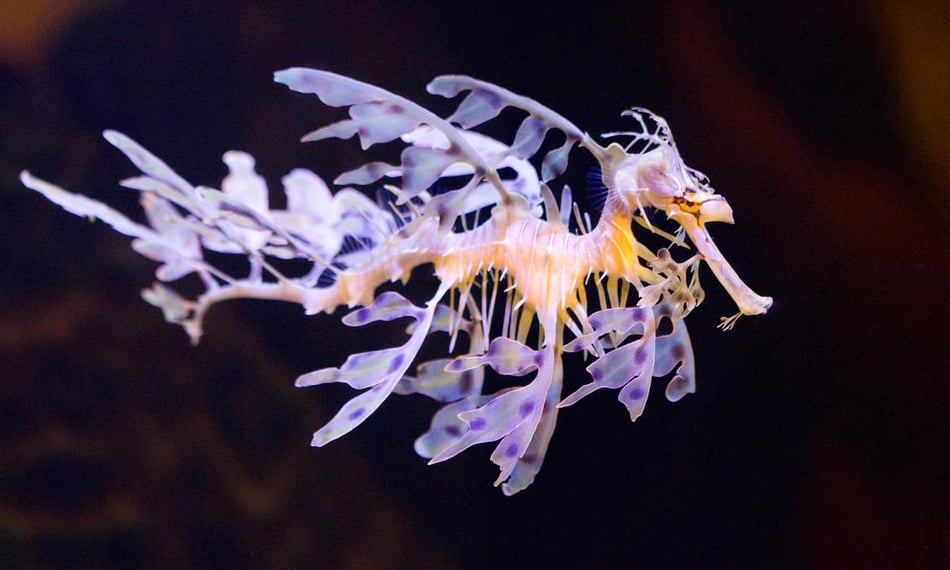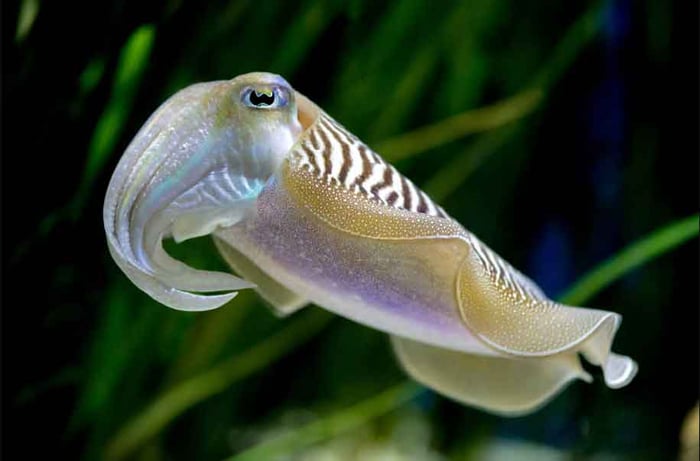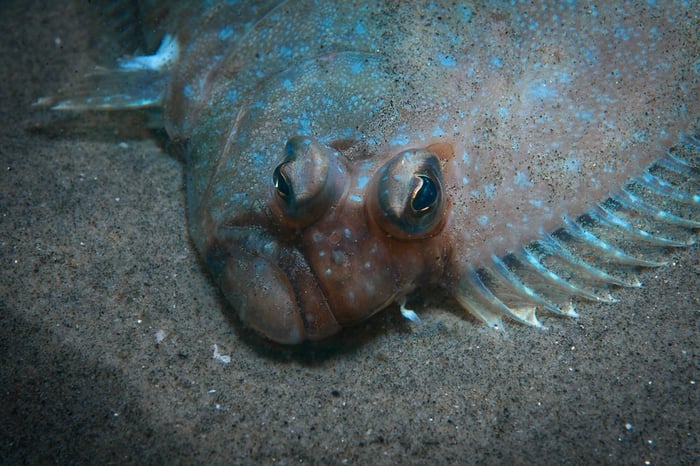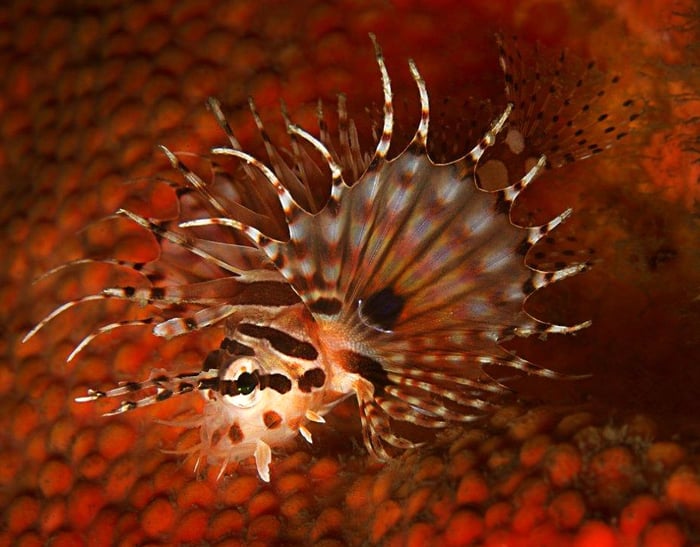In Plain Sight: The Incredible World of Camouflaged Marine Species

Tin
4
min. read

Camouflage, a survival technique used by countless species, is a fascinating phenomenon that underscores the rich biodiversity present in marine ecosystems.
Below are five intriguing marine species that rely on this adaptation for survival, further illustrating the complexity and beauty of life beneath the waves.
Below are five intriguing marine species that rely on this adaptation for survival, further illustrating the complexity and beauty of life beneath the waves.

1. Leafy Sea Dragons
Leafy sea dragons (Phycodurus Eques) are named after their leaf-like protrusions. These extensions, combined with their unique coloration, help them blend perfectly with the surrounding seaweed and kelp, providing a compelling camouflage. They are significantly larger than their closely related species, regular sea dragons, reaching lengths of up to one foot (30 cm).
These delicate creatures are not the strongest swimmers. Instead, they use their leafy appendages as a fitting adaptation to help them drift and blend in with their surroundings. The leafy sea dragon can change its body color to better match its environment, adding another level of complexity to its camouflage capabilities.

2. Cuttlefish
Cuttlefish (Sepiida), often referred to as the chameleons of the sea, possess one of the most sophisticated camouflage systems in the animal kingdom. With skin covered in specialized cells called chromatophores, they can rapidly alter their color and pattern to blend seamlessly with their surroundings. Cuttlefish can also change the texture of their skin to further match their environment. They can mimic the smoothness of sand or the ruggedness of a coral reef, providing a three-dimensional aspect to their camouflage.
In 2023, Woo et al. published a remarkable experiment involving cuttlefish. They presented a selection of these marine creatures with 30 fabric backgrounds unrolled on the floor of their tank. While the animals changed their colors and patterns, cameras recorded their behavior. Upon analysis, researchers found that each cuttlefish followed a unique pattern, moving intermittently toward their desired end pattern. They would pause at times, seemingly comparing themselves to the goal they wanted to achieve, and eventually stopped when satisfied. When one would encounter the same background it saw before, it wouldn’t take on the exact same pattern as previously used; instead, it would add a little change in detail.
This ability to alter color and texture allows Cuttlefish to adopt various roles in their ecosystem. They can either be predators, using their camouflage to sneak up on prey, or avoid being prey themselves by hiding in plain sight.

3. Decorator Crabs
Decorator crabs (Cryptodromiopsis antillensis; superfamily Majoidea) are unique crustaceans that engage in active camouflage. They attach materials from their environment, such as sponges, algae, and other small organisms, to the tiny hook-like structures on their bodies. This can help the crab become nearly invisible on the reef or seafloor they decided to scavenge for their materials.
Bristles attached to these special creatures act like velcro, allowing each crab to easily remove and replace what it has attached to its body as needed. This means that they can adapt to a variety of situations, including ones that might pose a danger to them. For instance, they might discard a previously scavenged ring of seaweed if they discover a stinging anemone that better serves as protection against potential threats like hungry fish or larger crabs.

4. Flatfish
Flatfish (Pleuronectiformes) belong to the family Pleuronectidae and are characterized by their flattened bodies and asymmetrical morphology. Unlike most fish, flatfish have both eyes on one side of their head, which allows them to lie flat on the ocean floor. They often bury themselves partially in the sand or mud, leaving only their eyes and upper side exposed. Some well-known flatfish species include flounders, sole, and halibut. Their slender, oval-shaped bodies and specialized fins make them perfectly adapted for living on the seabed.
Other than their unique body type, flatfish possess a remarkable ability to change their colors and patterns to match their surroundings. When a flatfish settles on the ocean floor, it skillfully adjusts its coloration to match the substrate beneath it. This remarkable ability allows them to remain undetected by predators searching for a meal and ensures that unsuspecting prey do not spot them as they patiently lie in wait for their next meal.
Flatfish are primarily carnivorous, and their diet typically includes small fish, crustaceans, and various marine invertebrates. Their ambush-style feeding strategy relies on stealth and surprise, utilizing their camouflage to remain inconspicuous until the perfect moment to pounce on unsuspecting prey.

5. Nepal Tiger
The body of the zebra lionfish (Dendrochirus zebra) is adorned with bold black and white stripes, resembling the majestic pattern of a zebra, from which it gets its name. These eye-catching stripes serve as the foundation for its camouflage strategy, allowing them to expertly blend into its coral reef habitat. At the heart of the zebra lionfish's camouflage lies the concept of disruptive coloration.
Disruptive coloration is a camouflage strategy used by animals to break up their body outline or create ‘fake’ depth edges, making it difficult for predators and prey to detect them. This means that they have light patches surrounded by a lighter outline or dark patches surrounded by a darker outline to help them hide effectively. The zebra lionfish employs disruptive coloration by creating an optical illusion, blending in with coral structures that have similar features. In addition to this, the striking color scheme of lionfish also gives the illusion that they are venomous or potentially dangerous to those around them.
The art of camouflage shines as a vital survival strategy for numerous marine animals, with each creature honing unique disguises to perfection. Blending into surroundings not only ensures safety from lurking predators but also grants a sneaky advantage in the quest for food. Delving into the wonders of marine camouflage helps us to gain a deeper appreciation for the diverse array of life that thrives beneath the waves. Camouflage, in all its splendid forms, serves as a testament to the richness of ocean life and reminds us of the crucial role we play in protecting its enchanting diversity for generations to come.
At IMARCS, we recognize the intrinsic value of every marine creature and deeply appreciate the unique adaptations that have allowed them to thrive in their underwater habitats. As we work tirelessly towards our conservation efforts, our mission is to ensure that the beauty and diversity of marine life are preserved for future generations. We firmly believe that each species plays a vital role in the delicate balance of marine ecosystems, and it is through our dedication to innovative mariculture solutions and the restoration of marine habitats that we seek to safeguard their existence.
Together we can make a real, positive, and measurable impact on our beloved planet.
Sources:
Decorator crab. Smithsonian Ocean. (2023, May 11). https://ocean.si.edu/ocean-life/invertebrates/decorator-crab
Flatfish, facts and photos. National Geographic. (n.d.). https://www.nationalgeographic.com/animals/fish/facts/flatfish-flounder-sole-haddock
Loy, S. (2022, February 21). The leafy seadragon is a master of camouflage. A Moment of Science - Indiana Public Media. https://indianapublicmedia.org/amomentofscience/the-leafy-seadragon-is-a-master-of-camouflage.php
McGrouther, M. (2021, January 19). Zebra lionfish, Dendrochirus Zebra (cuvier, 1829). The Australian Museum. https://australian.museum/learn/animals/fishes/zebra-lionfish-dendrochirus-zebra/
Meet the common cuttlefish. Montereybayaquarium.org. (n.d.). https://www.montereybayaquarium.org/animals/animals-a-to-z/common-cuttlefish
Price, N., Green, S., Troscianko, J., Tregenza, T., & Stevens, M. (2019). Background matching and disruptive coloration as habitat-specific strategies for camouflage. Scientific Reports, 9(1).
Woo, T., Liang, X., Evans, D. A., Fernandez, O., Kretschmer, F., Reiter, S., & Laurent, G. (2023). The dynamics of pattern matching in camouflaging cuttlefish. Nature, 619(7968), 122–128.
Albert. (2021, March 12). Types of flatfish: The Complete Guide. FishingBooker Blog. https://fishingbooker.com/blog/types-of-flatfish-complete-guide/
Decorator crab. Smithsonian Ocean. (2023, May 11). https://ocean.si.edu/ocean-life/invertebrates/decorator-crab
Flatfish, facts and photos. National Geographic. (n.d.). https://www.nationalgeographic.com/animals/fish/facts/flatfish-flounder-sole-haddock
Loy, S. (2022, February 21). The leafy seadragon is a master of camouflage. A Moment of Science - Indiana Public Media. https://indianapublicmedia.org/amomentofscience/the-leafy-seadragon-is-a-master-of-camouflage.php
McGrouther, M. (2021, January 19). Zebra lionfish, Dendrochirus Zebra (cuvier, 1829). The Australian Museum. https://australian.museum/learn/animals/fishes/zebra-lionfish-dendrochirus-zebra/
Meet the common cuttlefish. Montereybayaquarium.org. (n.d.). https://www.montereybayaquarium.org/animals/animals-a-to-z/common-cuttlefish
Price, N., Green, S., Troscianko, J., Tregenza, T., & Stevens, M. (2019). Background matching and disruptive coloration as habitat-specific strategies for camouflage. Scientific Reports, 9(1).
Woo, T., Liang, X., Evans, D. A., Fernandez, O., Kretschmer, F., Reiter, S., & Laurent, G. (2023). The dynamics of pattern matching in camouflaging cuttlefish. Nature, 619(7968), 122–128.